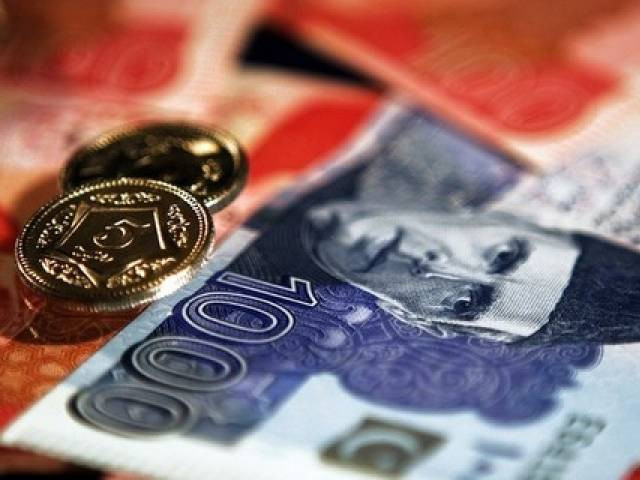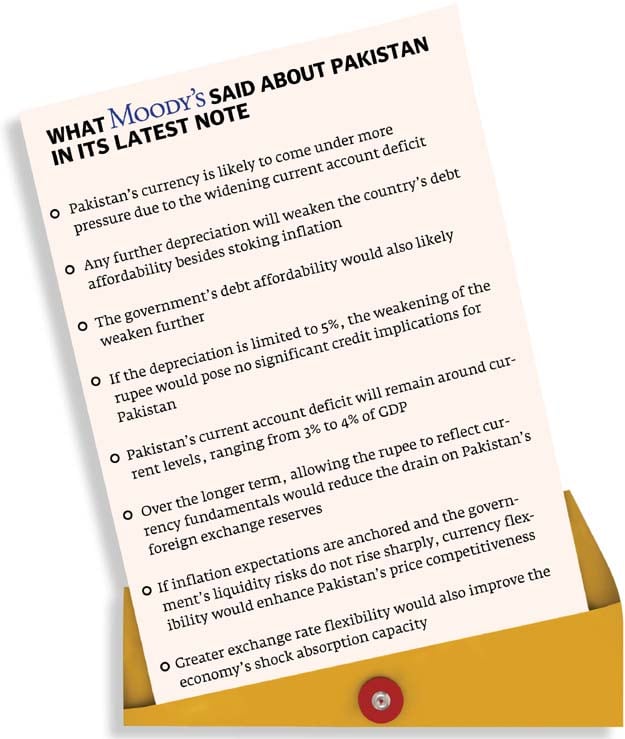Pakistan’s debt affordability will decrease if rupee weakens: Moody’s
Credit ratings agency says currency is still likely to come under pressure as current account deficit widens

Credit ratings agency says currency is still likely to come under pressure as current account deficit widens. PHOTO: BLOOMBERG
Moody’s - one of the top three global credit rating agencies - published the note a month after the State Bank of Pakistan (SBP) let the rupee weaken by close to 5%. “If the PKR (Pak rupee) depreciates markedly further, the country’s central bank will face the difficult challenge of anchoring inflation expectations at moderate levels,” said Moody’s.
It said that the Pakistani rupee will likely face ongoing depreciation pressures against the US dollar. The rupee movement came after a long period of a broadly unchanged exchange rate, except for a one-day spike in July 2017. Since December 12, 2017, the PKR has remained broadly unchanged at these weaker levels, it noted.
The government’s debt affordability would also likely weaken further, as the federal government’s one-third debt is denominated in foreign currency, said the ratings agency. It said that further depreciation of the rupee against the US dollar would increase the country’s debt burden.
The federal government’s debt was equivalent to 68% of Gross Domestic Product at the end of fiscal year 2017. Moody’s said that the ratio was “higher than the median estimate for B-rated sovereigns of 55% of GDP for 2017”.
Despite frequently changing the definition of public debt, the government has gone past its debt limitations, set out under the Fiscal Responsibility and Debt Limitation Act, said Senate Standing Committee on Finance Chairman Senator Saleem Mandviwalla.
In June 2013, when the PML-N government was elected into power, the debt-to-GDP ratio was 64%, according to Ehtisham Rashid, the director general at the Debt Management Office of the Ministry of Finance. In a briefing to the Senate Standing Committee, Rahid also said that by the end of fiscal year 2016-17, a majority of the country’s debt indicators “deteriorated”. He stated that about five indicators worsened but three saw an improvement.

On the medium-term, debt indicators are in the middle of the debt ceilings defined under the Medium Term Debt Management Strategy, he added.
Moody’s said that if the depreciation was limited to 5%, it would pose no significant credit implications for Pakistan.
“However, given the likely evolution of the current account, further depreciation pressures are likely,” it added. The credit ratings agency has estimated that Pakistan’s current account deficit will remain around current levels, ranging from 3% to 4% of GDP, due to the high import intensity of domestic-driven growth.
The current account deficit during first five months of the fiscal year amounted to $6.6 billion, according to the central bank.
We expect that the current account deficit will be around $14 billion by the end of the current fiscal year, said Qamar Abbasi, the acting additional secretary external finance of the finance ministry. He said that foreign debt repayment obligations for the full fiscal year were $6.1 billion.

Pakistan had closed the last fiscal year at a historical $12.4 billion current account deficit after imports surged to a record $53 billion.
The acting additional secretary said that things have improved in the first five months of the fiscal year and, at this point, the government did not feel the need to go to the international capital markets. In November 2017, Pakistan raised $2.5 billion by floating Eurobond and Sukuk bonds.
Moody’s said that over the longer term, allowing the rupee to reflect currency fundamentals would reduce the drain on Pakistan’s foreign exchange reserves. It added this will also enhance Pakistan’s capacity to absorb shocks to trade and or capital flows.
Pakistan’s official foreign currency reserves stood at $14.1 billion as of December 29, barely sufficient to cover a three-month import bill.
It said that if inflation expectations are anchored and the government’s liquidity risks did not rise sharply, currency flexibility would enhance Pakistan’s price competitiveness, “given the current overvaluation of the Pak rupee”.
The greater exchange rate flexibility would also improve the economy’s shock absorption capacity by incentivising the reallocation of resources between the tradable and non-tradable sectors of the economy, it added.
Published in The Express Tribune, January 10th, 2018.
Like Business on Facebook, follow @TribuneBiz on Twitter to stay informed and join in the conversation.


















COMMENTS
Comments are moderated and generally will be posted if they are on-topic and not abusive.
For more information, please see our Comments FAQ